Why has the Vatican, again, drawn a line in the sand, declaring that Catholics cannot become Freemasons? The decision, reaffirming a long-held stance, underscores a deep-seated historical and theological conflict between the Catholic Church and the secretive world of Freemasonry.
The Vatican's recent pronouncements, echoing centuries of suspicion and outright condemnation, leave no room for ambiguity. In a statement released through the Dicastery for the Doctrine of the Faith (DDF), and bearing the approval of Pope Francis, the Church has unequivocally stated that Catholics are forbidden from joining Masonic lodges. This prohibition isn't new; it’s a reiteration of existing canonical law and theological doctrine. The DDF, responding to queries from, among others, Bishop Julito Cortes of the Philippines, has made its position crystal clear: membership in Freemasonry is incompatible with Catholic faith.
To understand the intricacies of this ongoing feud, it’s crucial to examine the core tenets and historical context that fuel the Vatican's apprehension. The history between the Catholic Church and Freemasonry is a tapestry woven with threads of theological disagreement, perceived threats to authority, and mutual suspicion. For the Church, the very nature of Freemasonry – its secrecy, its emphasis on a non-denominational religious approach, and its own rituals and oaths – are at odds with core Catholic doctrines. Freemasonry, with its intricate symbols, rituals, and varying degrees of initiation, has long been viewed with skepticism by the Vatican. The Church believes that Freemasonry promotes a naturalistic view of God that rejects Church teaching and papal authority. Moreover, the Church is wary of the secrecy that shrouds Masonic gatherings, fearing that such clandestine meetings could harbor agendas detrimental to the Church’s influence and its flock.
The DDF's recent reaffirmation, a document signed by Pope Francis and DDF Prefect Cardinal Victor Fernández, serves as a clarion call to the faithful, reminding them of their obligations and the boundaries set by the Church. The Church’s stance isn't simply about enforcing rules; it's about safeguarding what it sees as the integrity of its doctrines and the spiritual well-being of its followers.
The roots of this tension can be traced back centuries. Freemasonry, which emerged in the late 17th and early 18th centuries, gained popularity during the Enlightenment era, a time of burgeoning scientific thought, philosophical inquiry, and societal change. The Catholic Church, clinging to its traditional role as the ultimate authority on matters of faith, found itself increasingly at odds with these new intellectual currents. Freemasonry, with its emphasis on reason, tolerance, and universal brotherhood, offered an alternative worldview, one that often clashed with the Church's teachings.
The Church's opposition to Freemasonry is not a recent phenomenon. It dates back to the 18th century, with various papal pronouncements and decrees condemning Freemasonry and forbidding Catholics from joining its ranks. These condemnations, often accompanied by warnings of excommunication, reflect the Church's fear of losing control over its followers and the erosion of its theological authority. For instance, in 1736, the Inquisition in Florence, Italy, investigated a Masonic lodge, eventually condemning it in 1737. This early encounter was spearheaded by the English Freemason Charles Sackville, 2nd Duke of Dorset, who established the lodge in 1733, though it welcomed Italian members, including Tommaso Crudeli, the lodge's secretary.
Throughout the centuries, the Church's stance has remained remarkably consistent, albeit with varying degrees of emphasis depending on the pontiff and the prevailing political climate. The Church's opposition has evolved over time, shaped by the specific historical contexts and the prevailing political and social currents. In the 19th century, for instance, the Church was often critical of Freemasonry's alleged involvement in revolutionary movements and its perceived role in undermining the temporal power of the papacy. This view was reinforced by the rise of anti-clerical sentiments and political movements that sought to diminish the Church's influence.
The Church's concerns also include Freemasonry’s universalism, which the Church sees as potentially downplaying the importance of the Catholic Church’s specific claims to religious truth. With its emphasis on a common, non-denominational spirituality, Freemasonry seemed to offer a competing path to spiritual fulfillment, one that did not necessarily require adherence to Catholic dogma or the Church's hierarchical structure.
The present reiteration of the ban isn't merely a legalistic decree; it reflects a deeper theological and pastoral concern. The Church's leaders are tasked with protecting the spiritual well-being of their flock, guiding them away from what they perceive as spiritual dangers. By forbidding Catholics from joining Freemasonry, the Church is attempting to safeguard its members from potentially compromising their faith and loyalty.
The decision, therefore, is not an isolated incident but rather a continuation of a long-standing pattern of scrutiny and disapproval. While the Catholic Church is not the only religious entity that has expressed reservations about Freemasonry, its condemnation carries significant weight, given its global reach and the number of Catholics worldwide. The Vatican’s latest confirmation, however, has done little to resolve the underlying tension between the two institutions. This ongoing prohibition raises several crucial questions about the nature of faith, secrecy, and the pursuit of knowledge. The conflict highlights fundamental differences in worldview and values, and as long as these core differences persist, the Vatican's position is unlikely to change.
The Freemasons themselves, a society that has an estimated global membership of up to six million, have their own perspectives on these matters. They generally describe themselves as a fraternal organization committed to promoting moral and ethical principles, self-improvement, and charitable endeavors. They see their gatherings as a forum for intellectual and spiritual growth. However, their emphasis on secrecy, their rituals, and their connections to the Enlightenment tradition of reason and tolerance can sometimes appear at odds with the Catholic Church’s insistence on adherence to dogma and its hierarchical authority. This contrast in worldviews has generated an enduring sense of mistrust and suspicion that has continued to shape relations between the two institutions.
The Freemasons’ history is steeped in symbolism and ritual. Their secret meetings, which are often held in grand lodges decorated with elaborate symbols and imagery, may create a sense of mystery that the Church finds concerning. The oaths and ceremonies, with their specific practices, are seen as potentially distracting from the core tenets of the Catholic faith. Furthermore, the universalist approach of Freemasonry, which welcomes members from diverse religious and philosophical backgrounds, is viewed with caution by the Church, which maintains a singular claim to truth and spiritual authority.
The Vatican’s position also appears to be influenced by historical events and geopolitical considerations. Throughout history, Freemasonry has often been associated with anti-clerical movements and political ideologies that challenged the Church's power. The Church believes that membership in such organizations could potentially expose its members to ideologies and political agendas that run counter to its teachings and interests. This concern is amplified in regions where the Church's influence is already under pressure, as in countries where the Church is facing political or social challenges.
The decision to re-emphasize the ban on Catholic participation in Freemasonry has broader implications. It can affect Catholics who may be considering joining Masonic lodges, as well as members who may already be involved. It compels Catholics to examine their religious beliefs and affiliations. They must consider the implications of adhering to the Church's teachings while maintaining membership in an organization that the Church views with suspicion. For the Church, it’s a test of loyalty, and it requires its members to show loyalty to their faith first.
The pronouncements also draw attention to the ongoing dialogue and discussions surrounding freedom of conscience and individual choice. The Church's prohibition raises complex questions about the relationship between religious authority and individual freedom, as well as the limits of tolerance. How does one reconcile the Church's insistence on its teachings with the individual’s right to explore different spiritual paths? What is the role of the Church in policing the beliefs and affiliations of its members? These are complex questions that go to the heart of the conflict between the Catholic Church and Freemasonry, and the ongoing discussion surrounding the ban illustrates the complexities of this long-standing dispute.
The Church's re-articulation of this ban has also spurred discussions about the interpretation of canon law and the role of the DDF in upholding the Church's teachings. The DDF, the body charged with safeguarding the doctrines of the Catholic Church, plays a crucial role in interpreting and applying Church law. Its decisions, such as the one re-affirming the prohibition on Freemasonry, have significant ramifications for the daily lives of Catholics worldwide. The role of the DDF and its pronouncements are often debated within the Church. Some praise the DDF for upholding theological orthodoxy, while others argue that the body should adopt a more open and inclusive approach.
The latest clarification from the Vatican is a clear reminder of the historical conflict between the two organizations and the differences in their fundamental tenets. The Church sees Freemasonry as a spiritual competitor, whose principles are at odds with its own teachings. The Church's ongoing opposition reflects the deep-seated suspicion of Freemasonry and the importance of preserving its theological authority.
In conclusion, the recent reiteration of the Vatican's ban on Catholics becoming Freemasons is not merely a matter of following regulations but a complex issue shaped by centuries of mutual suspicion, theological differences, and competing visions of the world. The Church's pronouncements reinforce the historical chasm between the two institutions, highlighting a fundamental clash in their values, beliefs, and objectives. The decision acts as a reminder to the faithful of their spiritual responsibilities and the Church's determination to defend its teachings.



